
Image courtesy of Lucas Jackson and Reuters
Contents

Image courtesy of Lucas Jackson and
Reuters
Well, no. I was just trying to use a familiar phrase to convey my meaning of
"the rise and fall and rise of our consensus views on the likelihood that life is common elsewhere in the universe."
I hope you'll forgive me.
There probably ARE real stock markets on other planets, but I'll leave them as a subject for a future talk...
What I'd like to do is to try to estimate what some people, at least, were thinking about the likelihood of life on other planets at different points in time. The attitudes of, say, the ancient Greek philosophers, were not the same as those of scientists in the nineteenth century ... were they? Let's take a look at some of the literature, both popular and scientific, to find out.
Perhaps we'll discover that modern humans are not as optimistic as our ancestors ...
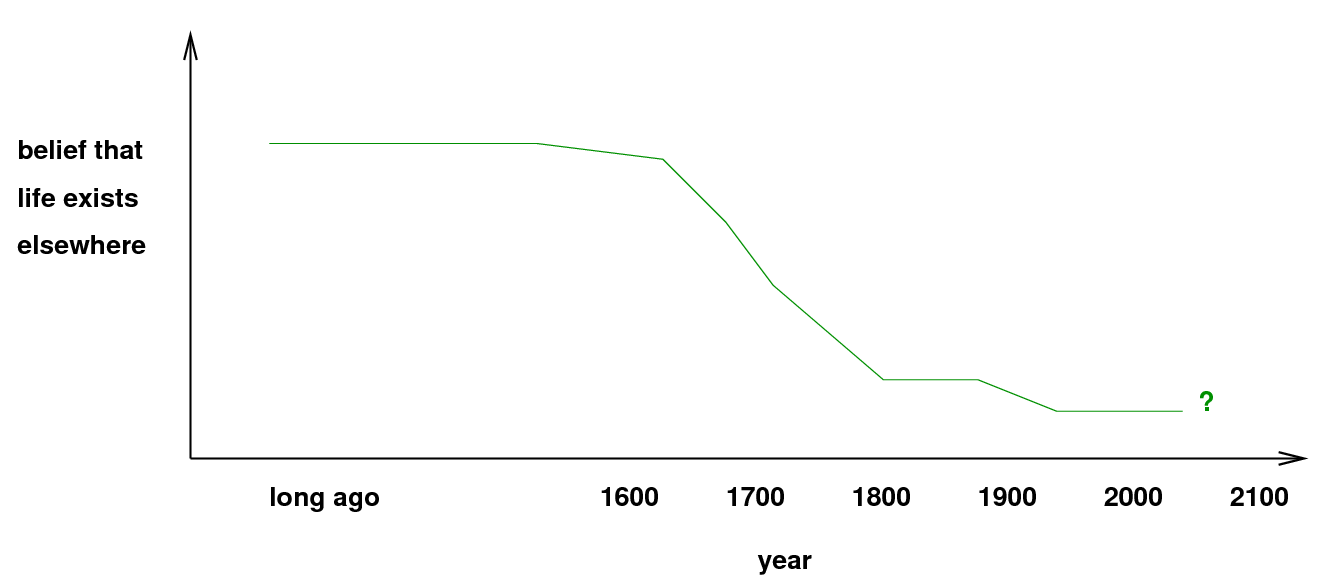
On the other hand, we find find that the current point of view is more favorable to the hypothesis of exterrestrial life ...
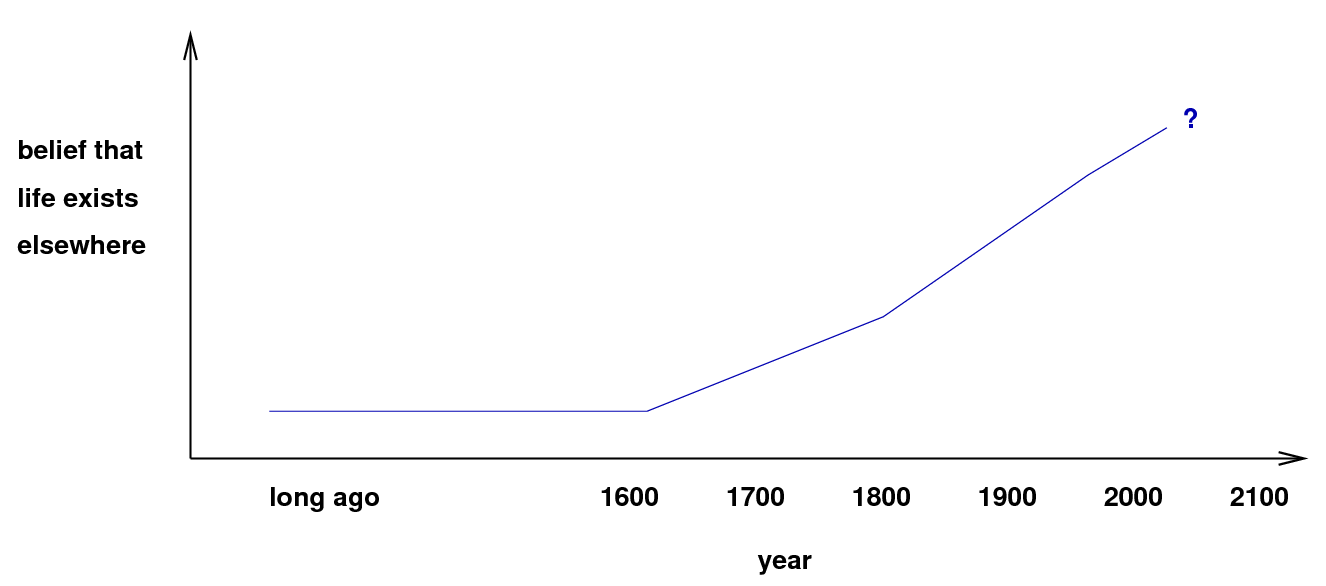
Or maybe there will be no fixed trend, only a series of changing attitudes ...
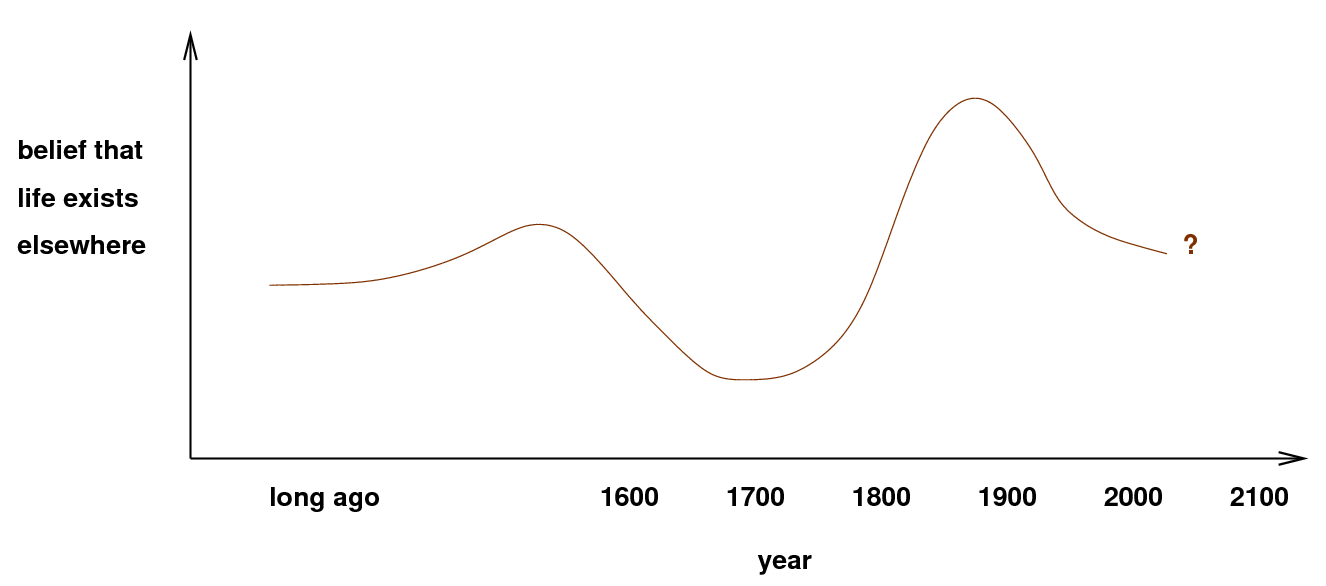
Of course, we can't possibly know what every person is or was thinking; and not everyone thinks alike. All I can do in this brief document is provide a few examples which have survived through the ages; not comprehensive in any way, nor definitive. Just a few bits and pieces which have survived and are reasonably well known. That's all.
With that in mind, let's go!
Many people in the ancient world believed that the heavens were filled by special beings, gods, spirits, and demons. Let's put such ideas aside, though, and look for situations involving the existence beyind the Earth of more mundane creatures: plants, animals, even people or people-like creatures.
One of the earliest statements concerning such beliefs comes to us indirectly. Although we have very little of the writings of Democritus of Thrace , born around 460 BC, and his mentor Leucippus, we know that they considered the Earth to be just one of innumerable other planets. The early Christian writer Hippolytus explains this idea of theirs in a book which does survive:
But Democritus was an acquaintance of Leucippus. This was Democritus of Abdera, son of Damasippus ... ... he speaks like Leucippus about elements, to wit, fulness and void, saying that the full is that which is but the void that which is not, and he said this because things are ever moving in the void. He said also that the ordered worlds are boundless and differ in size, and that in some there is neither sun nor moon, but that in others both are greater than with us, and in yet others more in number. And that the intervals between the ordered worlds are unequal, here more and there less, and that some increase, others flourish and others decay, and here they come into being and there they are eclipsed. But that they are destroyed by colliding with one another. And that some ordered worlds are bare of animals and plants and of all water.
So, one can infer that if some of those boundless worlds are "bare of animals and plants", then others must feature both fauna and flora. According to these two philosophers, then, space beyond the Earth is full of life.
Of course, others among the Greek philosophers argued for exactly the opposite. Plato and Aristotle, for example, believed that Earth was the only home for life.
The evidence which remains from these times long ago is so fragmentary that it's probably not fair to try to reach any conclusion about the "general consensus" on the question of extraterrestrial life. Let's just say that there was a range of opinions.
But certainly there were some who postulated that life might exist beyond the Earth. The Green biographer and writer Plutarch's dialogue On the Face of the Moon follows a discussion among learned friends of the physical nature of the Moon. It features reasonably accurate estimates of the Moon's size and distance from the Earth, and then goes on the more speculative topics. The speaker of the piece argues that it's quite possible that life may exist on the Moon, but that it may differ in some ways from the animals we see on the Earth.
The Moon was quite a popular location for life beyond Earth. During the second century AD, the Green writer and satirist Lucian of Samosata described in his A True History the fantastic voyage of a ship which is carried by a whirlwind all the way to the Moon.

Illustration by Ruth Cobb from
Chatterbox Children's Annual of 1926
There he meets Endymion, a fellow human who travelled to the Moon long ago, and has since been made King by the inhabitants. King Endymion enlists the aid of Lucian and his comrades in the war of the Lunarians against the inhabitants of the Sun; the two civilizations are fighting for the right to colonize Venus. Vegetables seem to play a major role in the combat.

Illustration from a 1647 Dutch edition of the True History,
courtesy of the British Library
The Lunarians win a victory in this pitched battle, but the crafty Solarians then build a giant wall around the the Moon to shield it from the light of the Sun, and Endymion is forced to sue for peace.
But the Greeks and Romans weren't the only people who pondered the existence of life beyond the Earth. Some time around the tenth century AD, members of high society in Heian Japan were enthralled by The Tale of the Bamboo Cutter (Taketori Monogatari). As he harvests bamboo in the forest one day, an old man cuts open a stalk and finds a tiny, beautiful girl inside.

Illustration by
Miyata Masayuki
She grows up to become a beautiful woman, whose looks, wit, and gentle ways cause many suitors to vie for her hand. Yet she feels unable to give herself to any man. Instead, she feels a strange connection to the Moon.
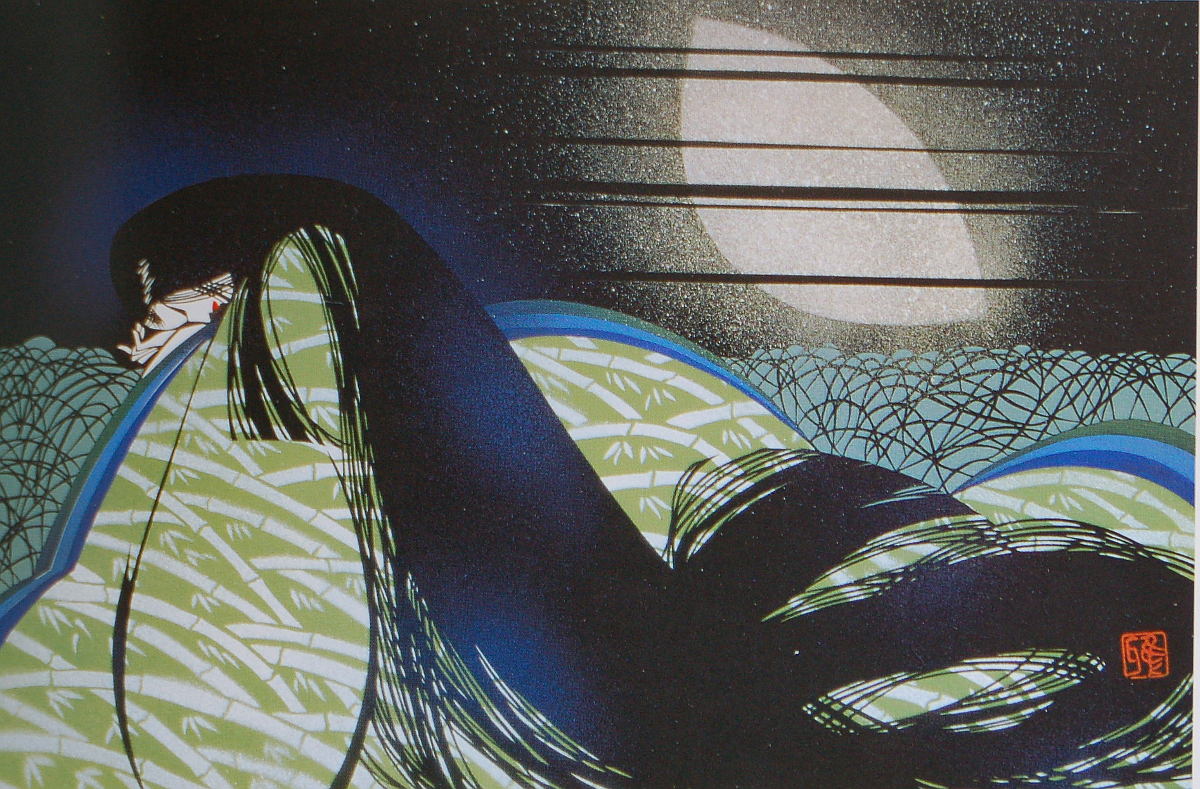
Illustration by
Miyata Masayuki
It turns out that she is, in fact, one of the Celestial Beings who live on the Moon. She was sent to Earth as a form of temporary exile, but must return to her true home once she has fully grown and realized her true identify.
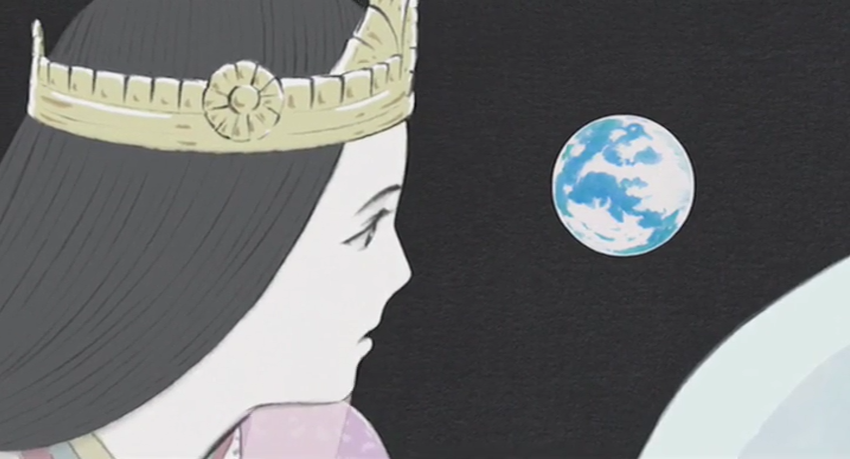
Still frame from
The Tale of Princess Kaguya
by Studio Ghibli
Moving back to Europe, and forward in time six centuries, we discover many more stories involving inhabitants of other worlds. One of the most widely read was The Man in the Moone, a curious but entertaining mixture of astronomy, adventure, and theology written by the English cleric Francis Godwin and published in 1638. The narrator of the story is trapped on the island of St. Helena; in order to escape, he tames and trains a small flock of geese to carry him in a sort of framework carriage.
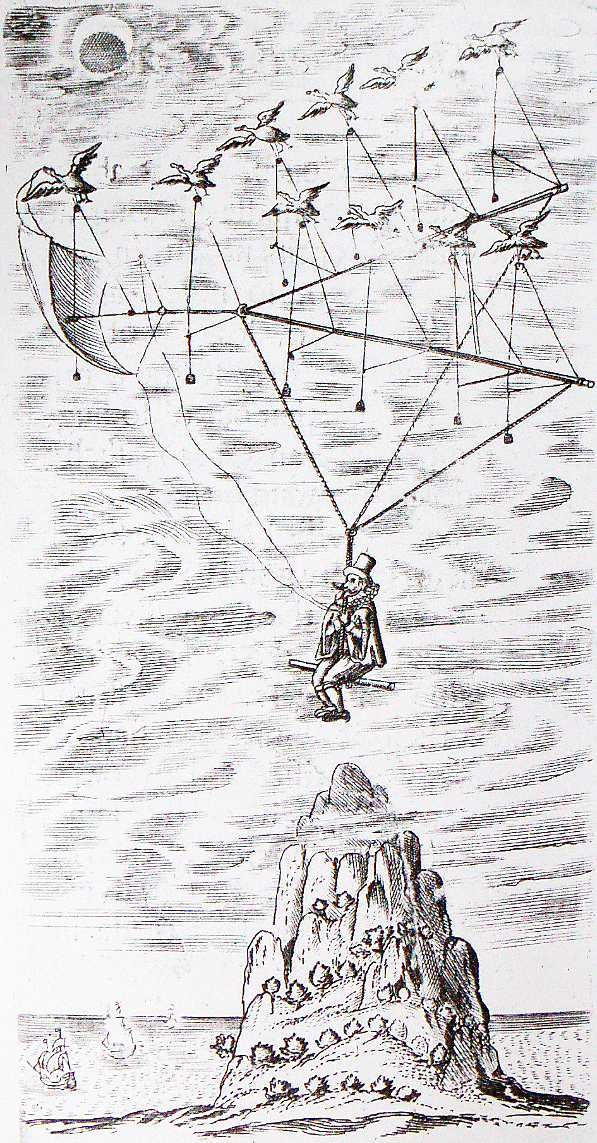
Frontispiece to
The Man in the Moone
To his surprise, the geese carry him, not simply to another island or the mainland, but far up into the air and away from the Earth, landing eventually on the Moon! He finds a world covered with trees, birds, beasts, and people -- all much larger than those on Earth.
For first I observed, that although the Globe of the Earth shewed much bigger there then the Moone doth unto us, even to the full trebling of her diameter, yet all manner of things there was of largenesse, and quantity, 10. 20. I thinke I may say 30. times more then ours. Their trees at least three times so high as ours, and more then five times the breadth and thicknesse.
Most of these creatures suffer a strange disability: as the Sun rises over the lunar landscape, they fall into a deep sleep which lasts the length of a lunar day (about 14 of our days), and wake up only when the Sun as set.
He makes his way to the leader of the lunar civilization, a being of great height, age, and wisdom. After telling the Monarch of his home, and how he came to reach the Moon, the narrator asks permission to return to the Earth. The Monarch grants it, and presents his visitor with numerous gifts, including a set of stones with special powers:
After returning to Earth in China, the narrator eventually makes his way back home to England.
One of the most charming depictions of extraterrestrial life comes in a collection of engravings titled A collection of the most notable things seen by Cavalier Wild Scull and Signor de la Hire on their famous voyage to the moon. Published in the mid-1700s, this series of illustrations by Filippo Morghen shows the inhabitants of the Moon in their everyday activities: fishing, hunting, sailing, and so forth. The lunar folk live in giant pumpkin-like gourds suspended over water for safety; the wild beasts apparently can't swim.

Plate from the series
A collection of the most notable things seen by
Cavalier Wild Scull and Signor de la Hire on their famous
voyage to the moon.
Among their ingenious contrivances are a self-powered sailboat that seems to defy Newton's Third Law ...

Plate from the series
A collection of the most notable things seen by
Cavalier Wild Scull and Signor de la Hire on their famous
voyage to the moon.
During the sixteenth and seventeenth centuries, a certain way of looking at the world -- making quantitative measurements of natural phenomena and looking for mathematical connections between them -- gradually became widespread. This was the start of the modern scientific age, and it brought both good news and bad news for those who hoped to find life in the heavens.
The main figures in the Nova Astronomia or "New Astronomy" were Nicolaus Copernicus

Image courtesy of
Wikipedia
who postulated that the Earth was not a unique world unlike any other, but just a planet, like Mars and Jupiter, which orbited the Sun. If the other planets were worlds like the Earth, then perhaps they, too, ought to support life.
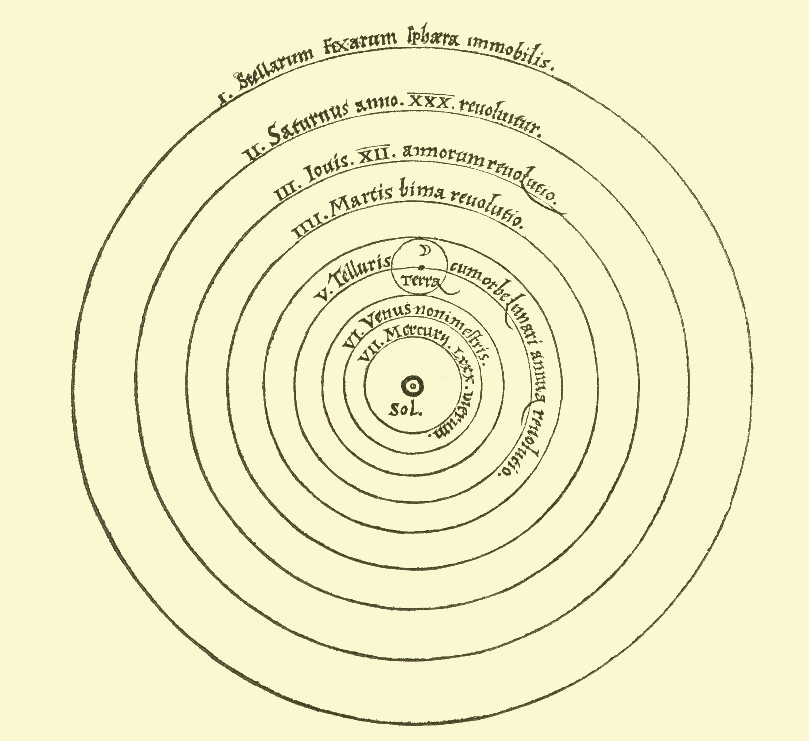
Image courtesy of
Wikipedia
Galileo Galilei was one of the most prolific scientific writers of his time, in subjects ranging from physics to optics to mechanics.

Image courtesy of
Wikipedia
He probably did not invent the telescope, but he did show what it could do when pointed to the night sky. His discovery of the largest moons of Jupiter was another blow to the idea that the Earth was somehow special, and gave further support to the idea that the other planets in our Solar System could be inhabited.

Image courtesy of
Pinterest
Johannes Kepler applied mathematics in new ways to explain the motions of the planets in the sky.

Image courtesy of
Wikipedia
His analysis of the orbit of Mars showed that it could be best described as an ellipse, not a circle; and his Three Laws of Planetary Motion set the stage for the next step in our understanding of their motion.
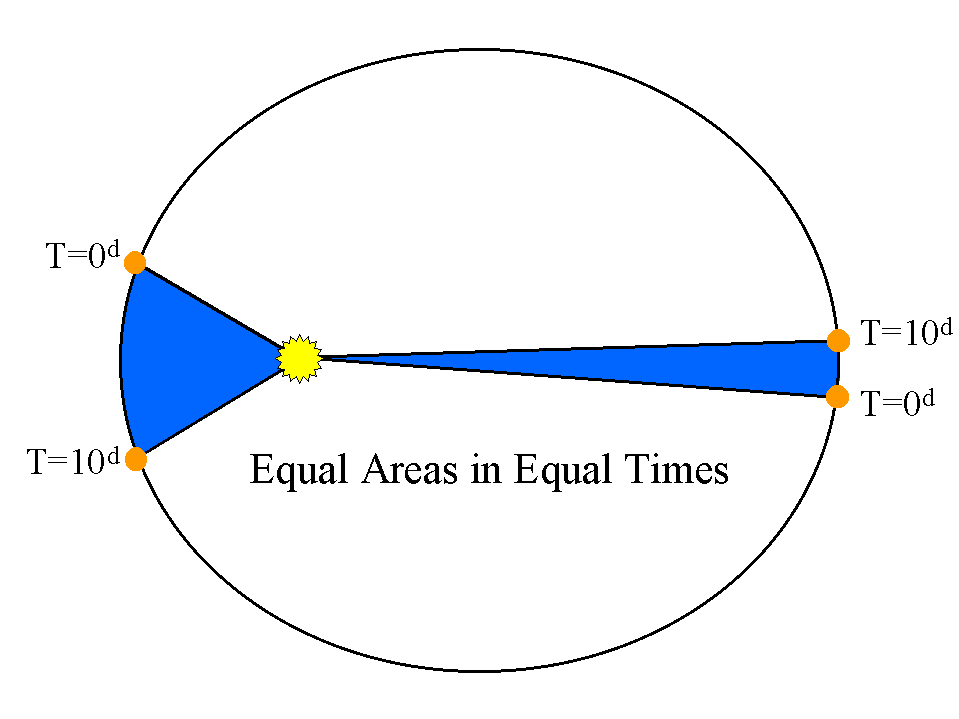
Image courtesy of
Richard Pogge
It was Isaac Newton who finally put all the pieces together. His Universal Theory of Gravitation explained the orbits of Moon around the Earth, the Earth and other planets around the Sun, and allowed scientists to compute what might happen if another star happened to wander past our Solar System.

Image courtesy of
Wikipedia
We can consider the effects of this scientific revolution on the possibility of life beyond the Earth in two ways:
Quite a few prominent scientists took the optimistic point of view. The Reverend Thomas Dick (1774 - 1857), for example, explained that among the millions of stars making up the Milky Way there must be countless planets inhabited by intelligent beings.
... that the universe is vast and extensive, beyond the range of human comprehension -- that it is peopled with myriads of inhabitants -- that these inhabitants are possessed of intellectual natures ...
William Herschel was the foremost observer of his day. Using telescopes which he built himself, he discovered the planet Uranus and made catalogs of nebulae and star clusters which were unmatched for over a century. He interpreted some of the features on the Moon as structures built by the Lunarians. In the excerpt from a letter he wrote below, he uses the word "Circus" to refer to the circular features we now call "Craters."
As upon the Earth several Alterations have been, and are daily, made of a size sufficient to be seen by the inhabitants of the Moon, such as building Towns, cutting canals for Navigation, making turnpike roads &c: may we not expect something of a similar Nature on the Moon? - There is a reason to be assigned for circular-Buildings on the Moon, which is that, as the Atmosphere there is much rarer than ours and of consequence not so capable of refracting and (by means of clouds shining therein) reflecting the light of the sun, it is natural enough to suppose that a Circus will remedy this deficiency, For in that shape of Building one half will have the directed light and the other half the reflected light of the Sun. Perhaps, then on the Moon every town is one very large Circus? Should this be true ought we not to watch the erection of any new small Circus as the Lunarians may the Building of a new Town on the Earth... By reflecting a little on the subject I am almost convinced that those numberless small Circuses we see on the Moon are the works of the Lunarians and may be called their Towns
The Moon wasn't the only likely home for extraterrestrials, according to Herschel. His observations of sunspots led him to believe that the glowing face of the Sun is due to a luminous outer atmosphere which covers and hides a darker, cooler, solid surface.
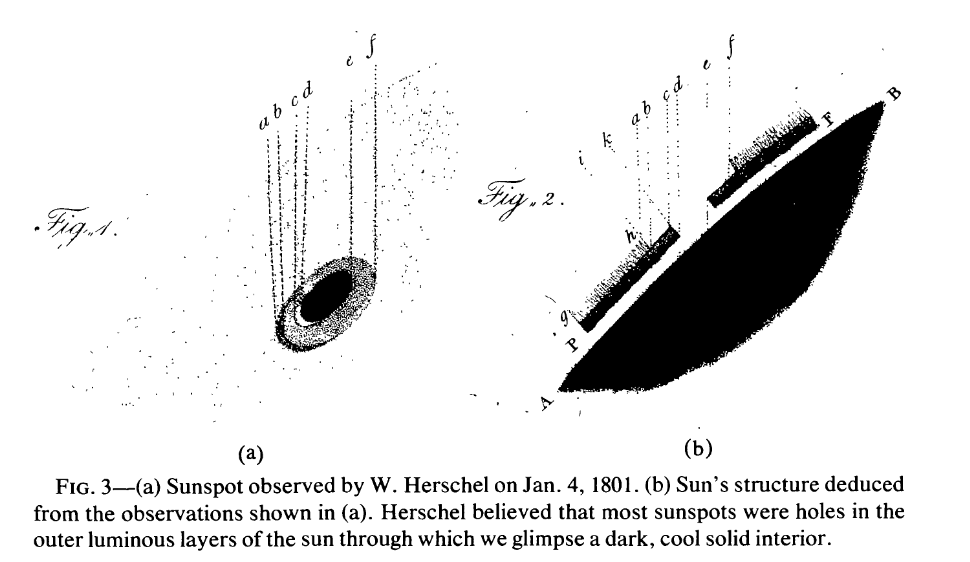
Image taken from
Kawaler and Veverka, JRASC 75, 46 (1981)
In a paper published in Philosophical Transactions of the Royal Society of London, Volume 85 (1795) , Herschel described his model of the Sun's structure and included this paragraph:
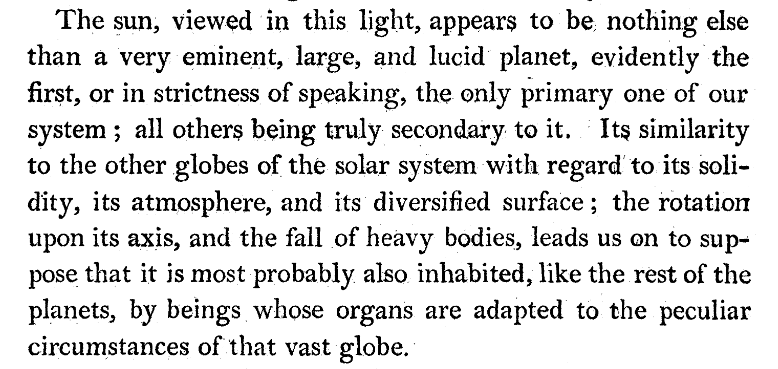
Image taken from
Philosophical Transactions of the Royal Society of London, 85, p 46 (1795)
In the late nineteenth century, the planet Mars became the major focus of extraterrestrial studies, as scientists realized that its surface offered the closest match in the Solar System to the Earth. A number of observers, straining their eyes to capture the detail visible during brief moments of clarity, reported a set of linear features stretching across the face of the planet.
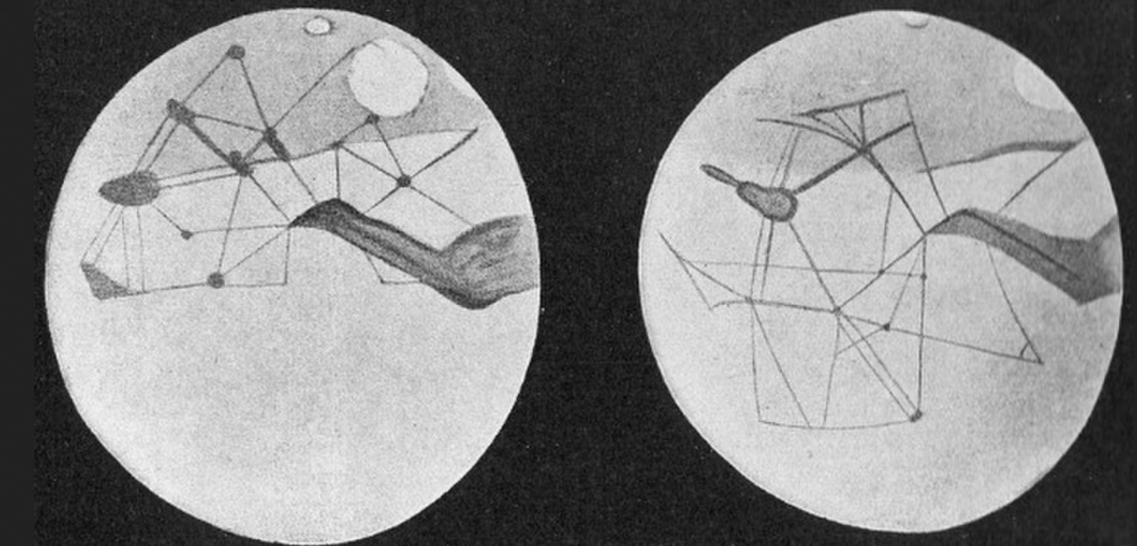
Drawings of Mars by Percival Lowell, courtesy of
Space.com
One man in particular was fascinated by these faint, fleeting lines. Percival Lowell built a private observatory in the hills outside Flagstaff, Arizona, seeking the best possible conditions for his study of Mars.

Photograph of Percival Lowell courtesy of
Wikipedia and the US Library of Congress
Over a period of several decades, Lowell's maps of Mars acquired more and more of these features, eventually becoming a network of overlapping and intersecting lines.
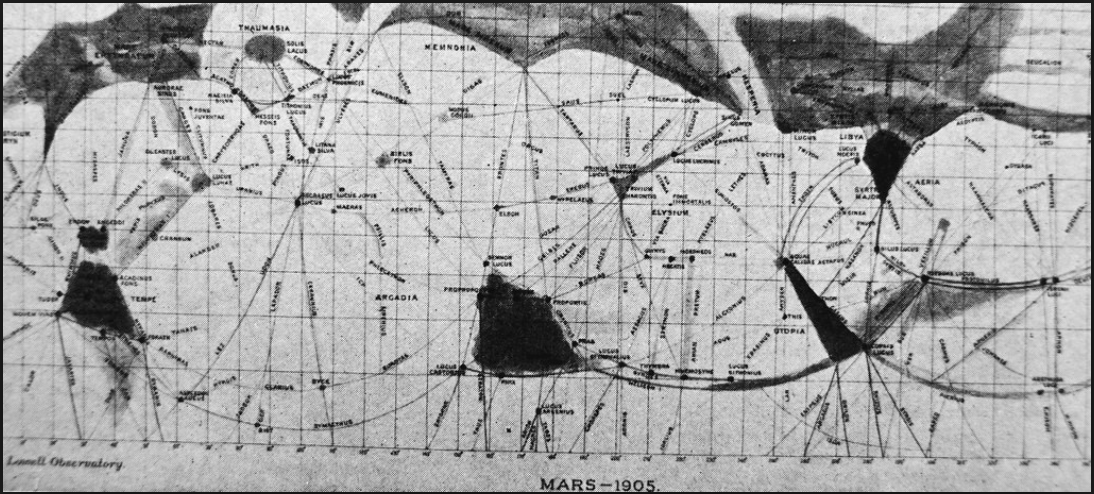
Maps taken from Lowell's book
Mars and its Canals (1906)
Based on the changes in the planet's appearance over the course of its seasons, Lowell developed the theory that these lines were a network of canals, built by the Martian civilization to carry precious water from the polar ice caps to cities and fields. His idea of a society trapped on a dying planet, creating giant engineering projects in a desperate struggle to survive, caught the popular imagination. Over the next few decades, the inhabitants of Mars were a staple of both popular and science fiction. The general belief in extraterrestrial life was at a high point.

View of Martian canal by
Chesley Bonestell
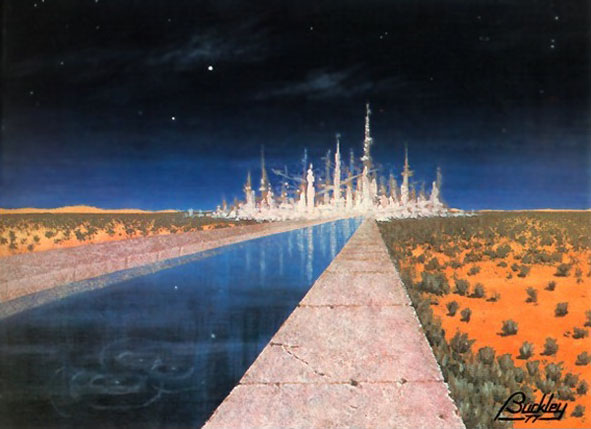
Canal leading to a Martian city,
by ? Buckley (1977?)
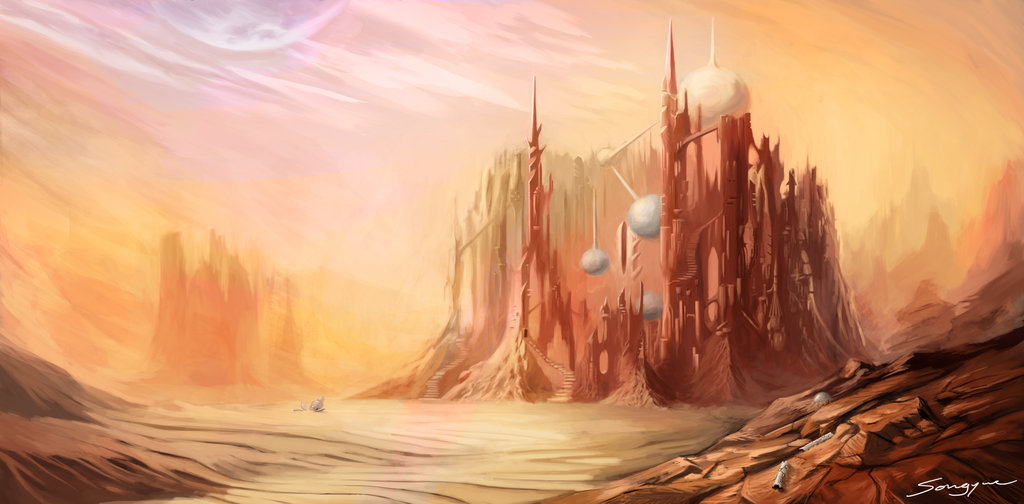
"Mars Research Facility", by
FreshTofu (Songyue Huang)
Let's take a brief pause in our tour of history to consider one rather numerical approach to the question of extraterrestrrial life. In 1961, astronomer Frank Drake wanted to help frame the debate over the likelihood of alien life. Was it so common that we should expend some scientific resources trying to find it? Or was it likely to be so rare that any search for alien radio signals would be futile and a waste of precious telescope time?
He combined a number of factors which bear upon the evolution of life. We don't know the values of these factors very well, so the result is always a guess, but at least this is one way to talk about the question.
Let's try it out!

Image courtesy of Dr. Molecule
In the early 1900s, several astronomers devised a new theory to explain the process by which planets might be formed around stars. The tidal theory of planet formation postulated that the Sun was originally the only body in the solar system. However, at some point, another star just happened to fly through space close enough to the Sun that its gravitational force pulled out a tendril of gas from the outer atmosphere of the Sun.
As the gas in that tendril cooled and collapsed, it formed
the planets we see today; that was the theory.
One of the important consequences of the theory
is that this sort of near-collision between stars
should be very uncommon.
The distances between stars are SO LARGE relative
to their sizes that it would take a very long time
for the random motions of stars to bring one close
enough to another to pull off material which could form planets.
Just how long a time?
Well, to give you an idea, let's set up a scale model.
Imagine the local Rochester area -- say, a few square miles
around RIT.
Place some ordinary soccer balls on the ground,
separated by about 2 miles.
(Note that the balls are drawn way too big in this diagram below)
Now, we let the soccer balls roll in random directions.
Each day, a ball rolls forward by one foot.
The length of time it will take for one soccer ball to bump
into another is about the same length of time it would
take a passing star to come close enough to the Sun
to form the planets:
many hundreds of billions of years,
far longer than the age of the universe.
According to this tidal theory,
only a very few stars in our entire Milky Way Galaxy
would have experienced a near collision;
and so the chances that any other star has planets
around it would be very, very small.
Maybe
1 chance in a billion.
Let's see what this does to the overall number
of civilizations in our galaxy.
Uh-oh.
The extraterrestrial stock market
has just taken a dive.
This theory of planet formation implied that our Solar System
was one of very few in the Galaxy.
Only a handful of other stars might have planets orbiting
around them.
The prospects for life on planets circling other stars
looked dim.
But, on the bright side, there WERE other planets orbiting
our Sun, right?
So we could still hope to find life on some other planet --
such as, for example, Mars.
In the middle of the twentieth century,
those looking for extraterrestrial life pinned their
hopes on the Red Planet.
Measurements of the surface properties of Mars
indicated that its atmosphere was thin, and that
the average surface temperature was considerably
lower than that of the Earth ...
but there was still a chance that life could
survive there.
In the 1960s, the US and the Soviet Union started
to send spacecraft to fly past the Red Planet,
in order to examine its properties more accurately.
The first of these missions to succeed was
Mariner 4, which swept past Mars in
mid-July, 1965.
Would we finally be able to see the all the
fine details of the canals?
Would fields of vegetation cover the plains?
And would there be any sign of the cities
built by Lowell's ancient civilization?
Take a look for yourself at some of the pictures
returned from the spacecraft.
In addition to its cameras, Mariner 4 carried instruments
to measure the properties of the Martian surface and atmosphere.
The data provided from these instruments led to sombre
conclusions:
This mission dealt a death blow to the advanced civilization
postulated by Percival Lowell and others,
and even to the much more modest hopes for simple vegetation.
Mars, it appeared, was not fit to be the abode for life.
To be fair, Mariner 4 was somewhat unlucky: the limited regions
it could see during its brief flyby turned out to be the
crater-filled, mountainous areas now known as the "highlands"
of the planet.
The more temperate and friendly lowlands,
visited decades later by other NASA missions,
provided modest improvements in conditions:
average daytime temperatures of "only" -60 C,
polar caps consisting of water ice (covered by thin
layers of frozen CO2),
traces of frost and water vapor
on the ground around landing sites,
and even occasional spots in which the
late afternoon temperature might rise above freezing.
But there's no doubt that the Martians were NOT coming
to take over the Earth.
And with that, the chances for finding life beyond the
Earth fell to a new and bitter low.
As you may recall, one of the arguments
against life on other planets was that,
according to the tidal theory of planetary formation,
planets circling other stars ought to be extremely rare.
But as decades passed in the twentieth centuries,
astronomers gradually discarded the tidal theory
in favor of the idea that planets formed from
the
circumstellar disks
which surround very young stars.
And so the evidence shows that planets around other
stars may not be rare; in fact, they may be common.
But -- wait a minute -- these disks around young stars
are simply the materials from which planets
MIGHT form.
Is there any evidence that planets have truly
condensed out of the gas and dust circling young stars?
In the early 1990s, astronomers using several different
techniques to search for extrasolar planets
found that the answer was YES!
The first method to yield a big crop of planets
was the radial velocity method.
The basic idea is to look for periodic variations
in the motion of a star, as it is pulled toward
and away from us by the gravitational force of
an orbiting planet.
A few years later, astronomers used a second
technique to find planets around other stars:
the transit method.
In this case, we look at a star, over and over
and over and over again.
Most of the time, we see exactly the same
amount of light -- boring.
But if a planet orbiting the star
happens to pass in front of it,
and blocks some of its light,
then we will notice a small dip in brightness.
Over the past 26 years,
astronomers have found lots and lots and LOTS
of extrasolar planets by these and other techniques.
At first, the number of new planets found each
year was in the tens or twenties or thirties ...
But after the
Kepler satellite
was launched in 2009,
the number of discoveries really took off.
As of TODAY, April 11, 2018,
there are a grand total of
according to the
NASA Exoplanet Archive.
In addition to finding planets in other stellar systems,
astronomers have been busy studying the properties
of the host stars, counting systems which contain
multiple planets, and looking for reasons to explain
why some stars do have planets, but others apparently do not.
One recent paper,
written by
Dressing and Charbonneau in 2015,
estimates the chances that a typical star
might have planets orbiting it:
Well, great!
If we take these estimates
and plug them into the Drake Equation,
let's see what happens.
It appears that the Extraterrestrial Stock Market
has made a considerable recovery!
We are likely to see even more exoplanet discoveries in the very
near future.
Sometime later this month,
perhap NEXT WEEK,
NASA will launch the
Transiting Exoplanet Survey Satellite (TESS).
TESS, like Kepler,
employs the transit technique to look for planets around
other stars.
Unlike Kepler, which was constrained to monitor stars in a few
small regions,
TESS will scan the entire sky.
The European Space Agency will join the effort, too,
launching later this year or early next year
its own mission:
CHaracterizing ExOPlanet Satellite (CHEOPS).
CHEOPS doesn't search for new planets;
instead, it will zoom in on a few of the most promising
Earth-like (and larger-than-Earth) planets
to measure their properties
more accurately.
After it has finished its observations of an exoplanet,
we'll know the physical properties of that world more precisely.
In short, to summarize the status of the
Exoplanet Stock Market in 2018,


Image courtesy of
Getty Images
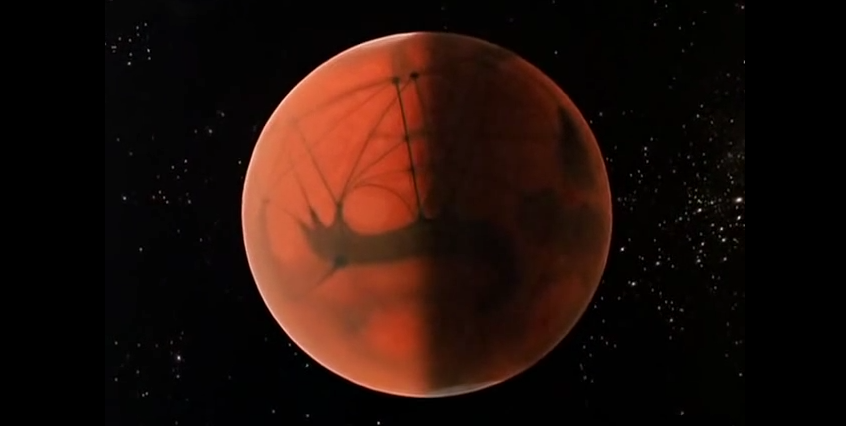
Still frame
taken
from Walt Disney's
Mars and Beyond (1957)
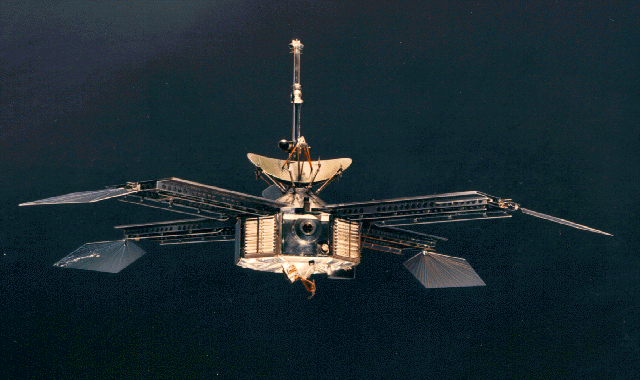
Image of Mariner 4 courtesy of
NASA
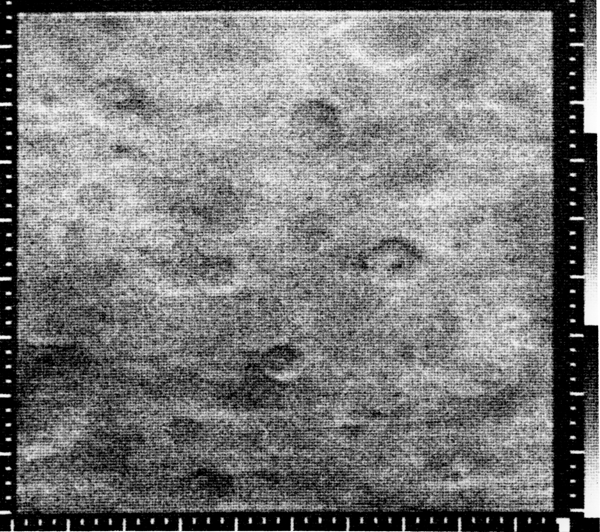
Mariner 4, image 09D, courtesy of
NASA and the NSSDC

Mariner 4, image 11E, courtesy of
NASA and the NSSDC
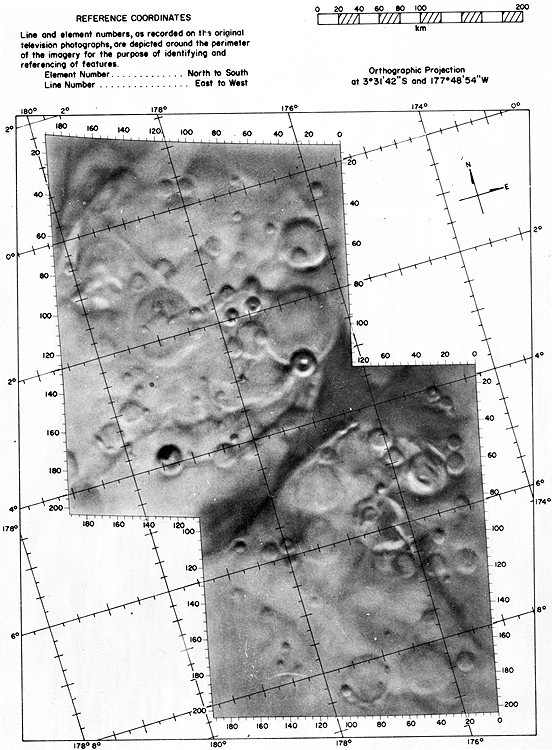
Mariner 4, orthographic shaded relief map based on frames 5 and 6, courtesy of
NASA and the NSSDC

Image courtesy of
Medium.com
The start of the recovery
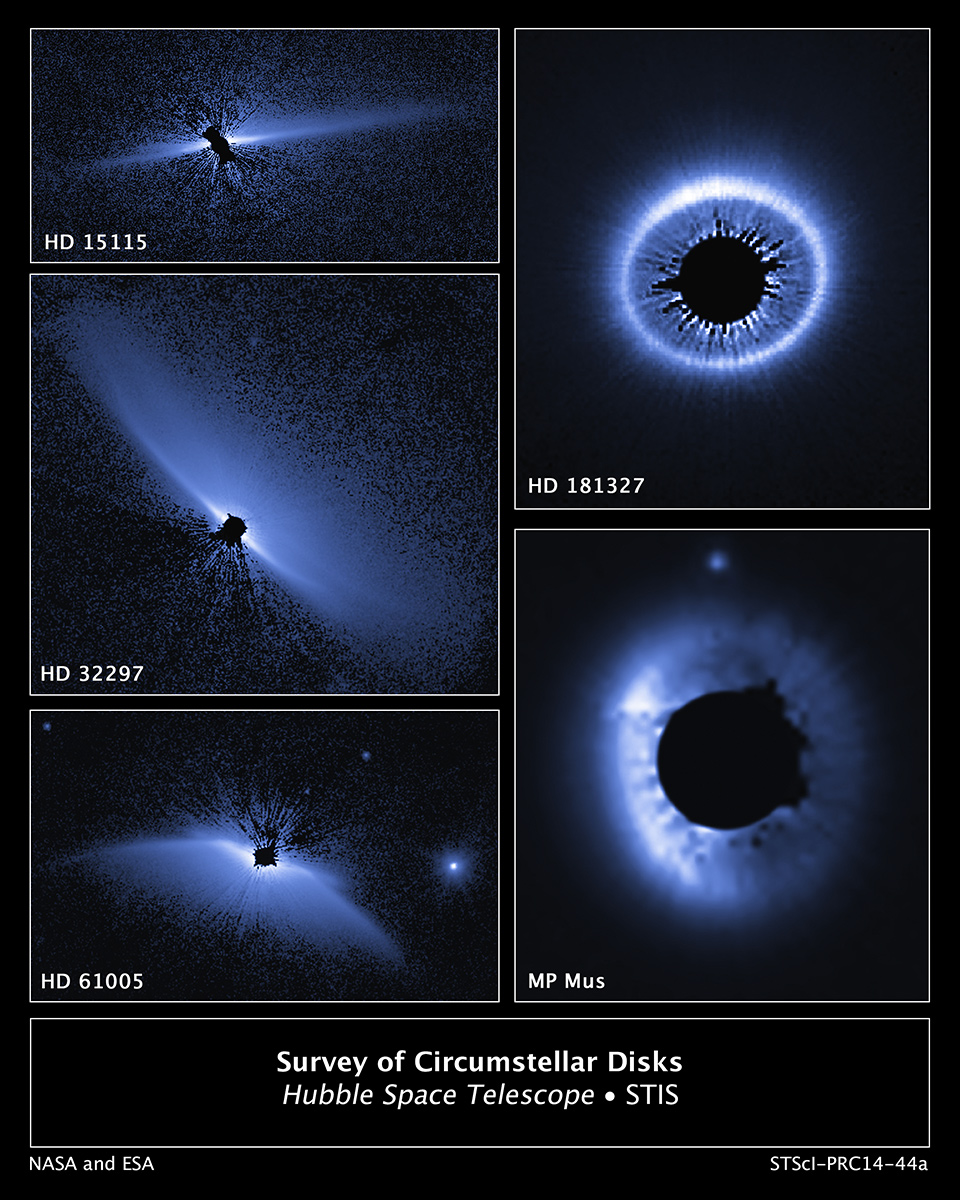
HST images of disks courtesy of
NASA and ESA

ALMA image of V1247 Ori courtesy of
Kraus et al., ApJ 848, L11 (2017)
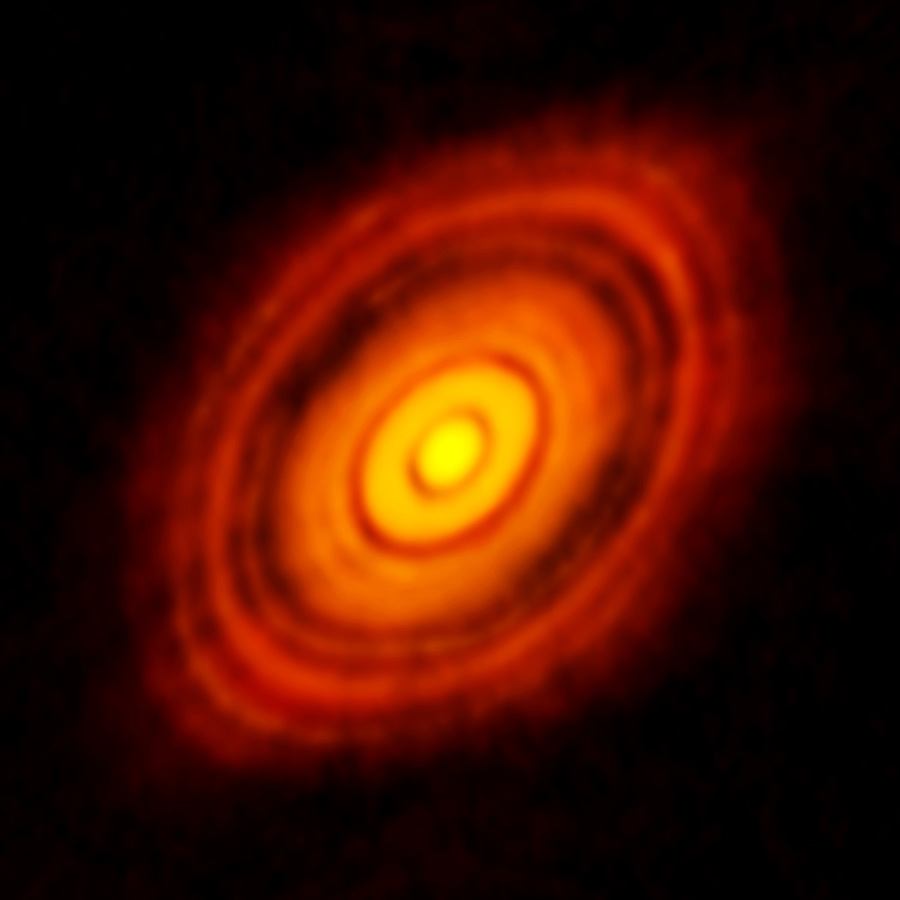
ALMA image of HL Tau courtesy of
Brogan et al., ApJ 808, L3 (2015)
Happy days are here again
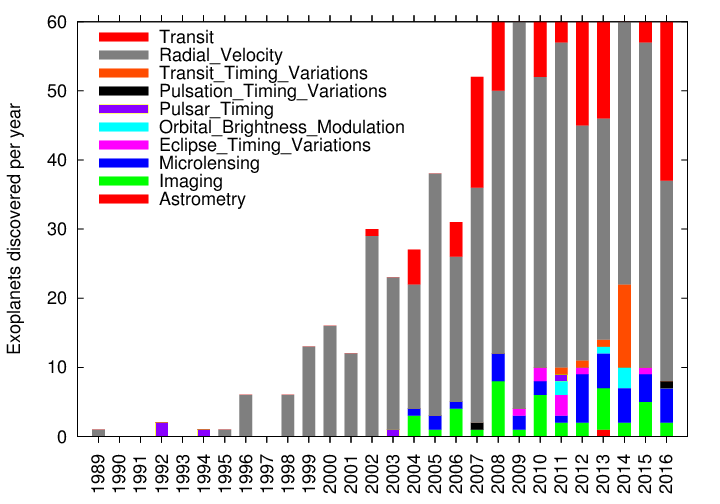
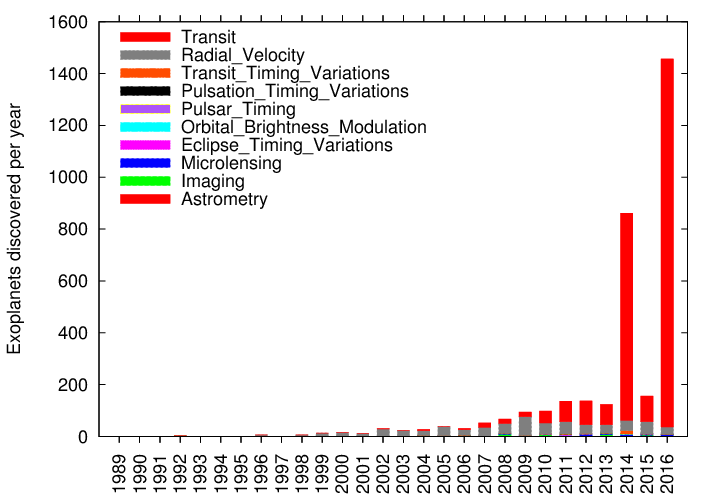
3711 planets confirmed to orbit other stars
In total, we estimate a cumulative planet occurrence rate of 2.5 +/-
0.2 planets per M dwarf with radii 1 - 4 R(solar)
and periods shorter than
200 days.
Within a conservatively defined habitable zone,
based on the moist greenhouse inner limit and
maximum greenhouse outer limit,
we estimate an occurrence rate of
0.16 Earth-size planets and
0.12 super-Earths per M dwarf [habitable zone]
Taken (and slightly simplified) from the abstract of
Dressing and Charbonneau, ApJ 807, 45 (2015)

Image courtesy of
e177.info
Bullish on the future
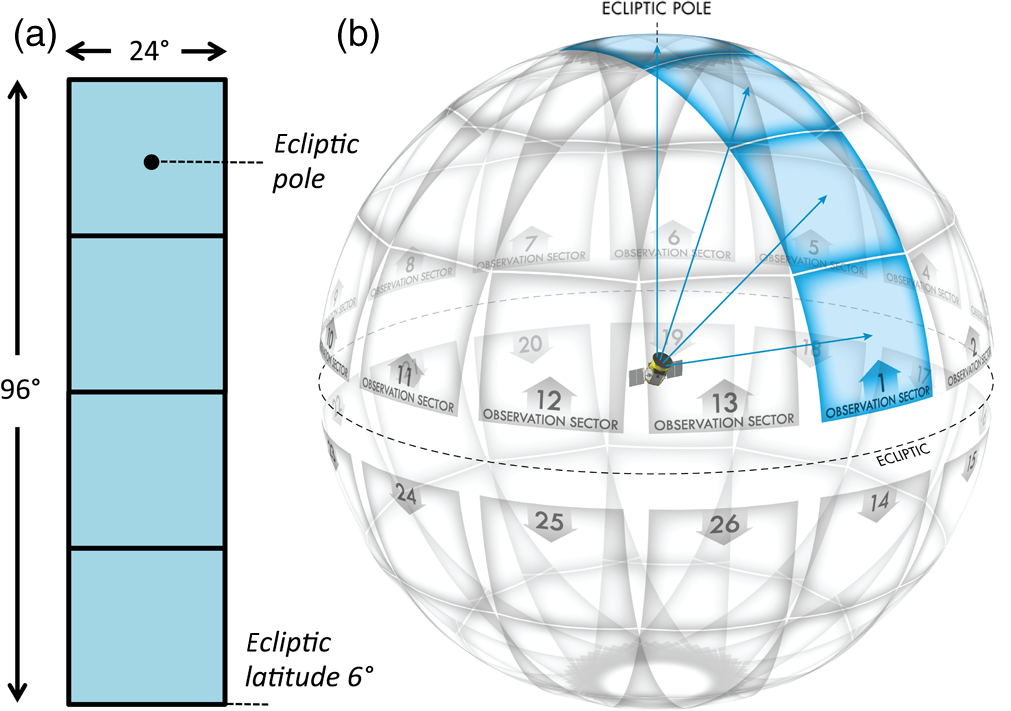
Image courtesy of
Ricker et al., SPIE 9143E, 20 (2014)
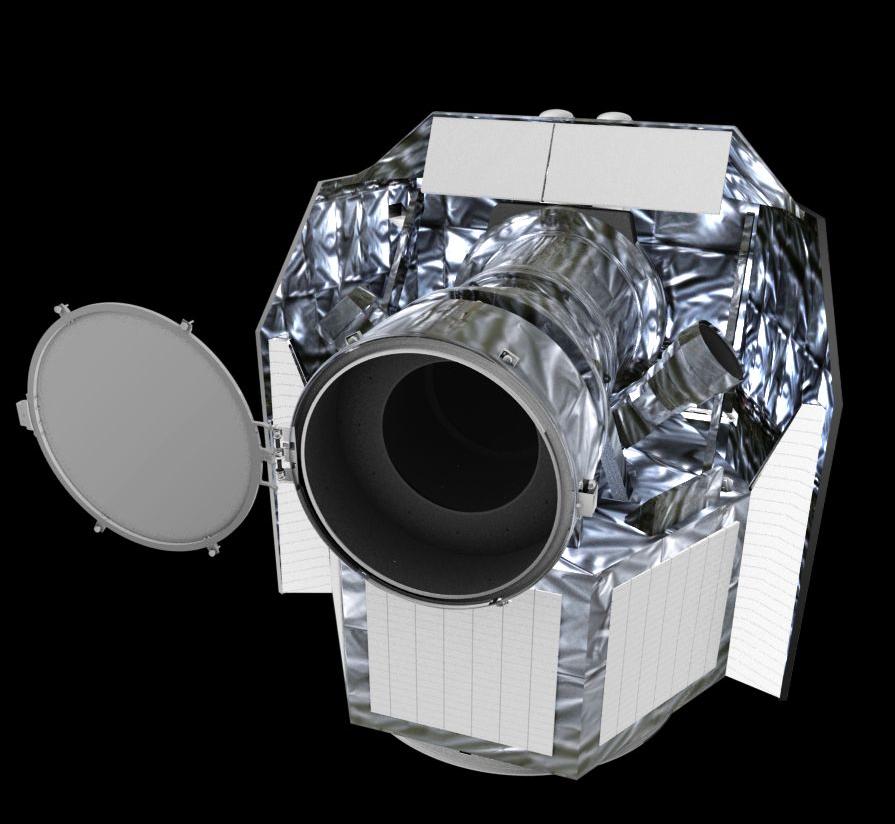
Image courtesy of
ESA - C. Carreau

Image courtesy of
Sheet Music Warehouse
For more information